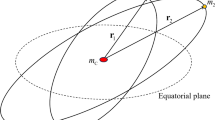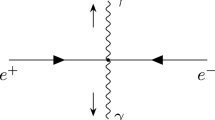Abstract
There is a growing population of relativistically relevant minor bodies in the Solar System and a growing population of massive extrasolar planets with orbits very close to the central star where relativistic effects should have some signature. Our purpose is to review how general relativity affects the orbital dynamics of the planetary systems and to define a suitable relativistic correction for Solar System orbital studies when only point masses are considered. Using relativistic formulae for the N body problem suited for a planetary system given in the literature we present a series of numerical orbital integrations designed to test the relevance of the effects due to the general theory of relativity in the case of our Solar System. Comparison between different algorithms for accounting for the relativistic corrections are performed. Relativistic effects generated by the Sun or by the central star are the most relevant ones and produce evident modifications in the secular dynamics of the inner Solar System. The Kozai mechanism, for example, is modified due to the relativistic effects on the argument of the perihelion. Relativistic effects generated by planets instead are of very low relevance but detectable in numerical simulations.
Similar content being viewed by others
References
Adams F.C., Laughlin G. (2006) Effects of secular interactions in extrasolar planetary systems. Astrophys. J. 649: 992–1003
Anderson J.D., Esposito P.B., Martin W., Muhlemsn D.O. (1975) Experimental test of general relativity using time-delay data from Mariner 6 and Mariner 7. Astrophys. J. 200: 221–233
Barnes R., Quinn T. (2001) A statistical examination of the short-term stability of the upsilo andromedae planetary system. Astron. J. 550: 884–889
Brumberg, V.: Essential Relativistic Celestial Mechanics. Adam Hilger, London. ISBN 0-7503-0062-0 (1991)
Brumberg V. (2007) On derivation of EIH (Einstein-Infeld-Hoffman) equations of motion from the linearized metric of general relativity theory. Celest. Mech. 99: 245–252
Brumberg V., Kopeikin S. (1989a) Relativistic reference systems and motion of test bodies in the vicinity of the Earth. Nuovo Cimento B 103(1): 63–98
Brumberg, V., Kopeikin, S.: Relativistic theory of celestial reference frames. Reference frames in astronomy and geophysics, pp. 115–141 (1989b)
Chambers J.E. (1999) A hybrid symplectic integrator that permits close encounters between massive bodies. MNRAS 304: 793–799
Ciufolini I. (2007) Dragging of inertial frames. Nature 449(7158): 41–47
Damour T., Soffel M., Xu C. (1991) General-relativistic celestial mechanics. I. Method and definition of reference systems. Phys. Rev. D 43: 3273–3307
Damour T., Soffel M., Xu C. (1992) General-relativistic celestial mechanics. II. Translational equations of motion. Phys. Rev. D 45: 1017–1044
Damour T., Soffel M., Xu C. (1993) General-relativistic celestial mechanics. III. Rotational equations of motion. Phys. Rev. D 47: 3124–3135
Duncan M.J., Levison H.F. (1997) A scattered comet disk and the origin of Jupiter family comets. Science 276: 1670–1672
Einstein A., Infeld L., Hoffman B. (1938) The gravitational equations and the problem of motion. Ann. Math. 39: 65–100
Everhart, E.: An efficient integrator that uses Gauss-Radau spacings. In: Carusi, A., Valsecchi, G.B. (eds.) Proceedings of IAU Colloq. 83 Dynamics of Comets: Their Origin and Evolution. Astrophysics and Space Science Library, vol. 115, pp. 185–202 (1985)
Fernandez J.A., Gallardo T., Brunini A. (2002) Are there many inactive Jupiter-family comets among the near-Earth asteroid population?. Icarus 159: 358–368
Ferraz-Mello S., Michtchenko T.A., Roig F. (1998) The determinant role of Jupiter’s great inequality in the depletion of the hecuba gap. Astron. J. 116: 1491–1500
Gallardo T. (2006) Atlas of the mean motion resonances in the Solar System. Icarus 184: 29–38
Gomes R., Gallardo T., Fernandez J.A., Brunini A. (2005) On the origin of the high-perihelion scattered disk: the role of the Kozai mechanism and mean motion resonances. CM&DA 91: 109–129
Gozdziewski K., Konacki M., Wolszczan A. (2005) Long-term stability and dynamical environment of the PSR 1257+12 planetary system. ApJ. 619: 1084–1097
Griffiths, D.: Introduction to electrodynamics. Prentice Hall (1999)
Iorio L. (2005) On the possibility of measuring the solar oblateness and some relativistic effects from planetary ranging. A&A 433: 385–393
Klioner S.A., Soffel M.H. (2000) Relativistic celestial mechanics with PPN parameters. Phys. Rev. D 62: 024019
Kopeikin S. (1988) Celestial coordinate reference systems in curved space-time. Celestial Mech. 44(1–2): 87–115
Kopeikin S., Vlasov I. (2004) Parametrized post-Newtonian theory of reference frames, multipolar expansions and equations of motion in the N-body problem. Phys. Rep. 400(4–6): 209–318
Laskar J. (1988) Secular evolution of the solar system over 10 million years. A&A 198: 341–362
Laskar J. (1996) Large scale chaos and marginal stability in the Solar System. CM&DA 64: 115–162
Lykawka P.S., Mukai T. (2006) Exploring the 7:4 mean motion resonance—II: scattering evolutionary paths and resonance sticking. P&SS 54: 87–100
Mardling R.A., Lin D.N.C. (2004) On the survival of short-period terrestrial planets. Astrophys. J. 614: 955–959
Marzari F., Scholl H. (2002) On the instability of Jupiter’s trojans. Icarus 159: 328–338
Michel P., Froeschlé Ch. (1997) The location of linear secular resonances for semimajor axes smaller than 2 AU. Icarus 128: 230–240
Michel P., Thomas F. (1996) The Kozai resonance for near-Earth asteroids with semimajor axes smaller than 2 AU. A&A 307: 310
Michtchenko T.A., Ferraz-Mello S. (2001) Resonant structure of the outer Solar System in the neighborhood of the planets. Astron. J. 122: 474–481
Misner, C.W., Thorne, K.S., Wheeler, J.A.: Gravitation. W.H. Freeman (1973)
Morbidelli, A.: Modern Celestial Mechanics. Taylor & Francis (2002)
Nagasawa M., Lin D.N.C. (2005) The dynamical evolution of the short-period Extrasolar planet around upsilo andromedae in the pre-main-sequence stage. Astrophys. J. 632: 1140–1156
Newhall X.X., Standish E.M., Williams J.G. (1983) DE 102-A numerically integrated ephemeris of the moon and planets spanning forty-four centuries. A&A 125: 150–167
Pireaux S., Rozelot J.-P. (2003) Solar quadrupole moment and purely relativistic gravitation contributions to Mercury’s perihelion advance. Ap&SS 284: 1159–1194
Pitjeva E.V. (2005) High-precision ephemerides of planets-EPM and determination of some astronomical constants. Solar Syst. Res. 39(3): 176
Quinn T., Tremaine S., Duncan M. (1991) A three million year integration of the earth’s orbit. Astron. J. 101: 2287–2305
Saha P., Tremaine S. (1992) Sympletic integrators for solar system dynamics. Astron. J. 104: 1633–1640
Shahid-Saless B., Yeomans D. (1994) Relativistic effects on the motion of asteroids and comets. Astron. J. 107: 1885–1889
Shapiro I.I., Ash M.E., Smith W.B. (1968) Icarus: further confirmation of the relativistic perihelion precession. Phys. Rev. Lett. 20: 1517–1518
Sitarski G. (1983) Effects of general relativity in the motion of minor planets and comets. Acta Astronomia 33: 295–304
Soffel M., Klioner S.A., Petit G., Wolf P., Kopeikin S.M., Bretagnon P., Brumberg V.A., Capitaine N., Damour T., Fukushima T., Guinot B., Huang T.-Y., Lindegren L., Ma C., Nordtvedt K., Ries J.C., Seidelmann P.K., Vokrouhlický D., Will C.M., Xu C. (2003) The IAU 2000 resolutions for astrometry, celestial mechanics, and metrology in the relativistic framework: explanatory supplement. Astron. J. 126(6): 2687–2706
Varadi F., Runnegar B., Ghil M. (2003) Successive refinements in long-term integrations of planetary orbits. Astrophys. J. 592: 620–630
Weinberg, S.: Gravitation and cosmology. Wiley (1972)
Will, C.M.: Theory and experiment in gravitational physics. Cambridge University Press (1981)
Will, C.M.: Theory and experiment in gravitational physics revised edition. Cambridge University Press (1993)
Will, C.M.: The confrontation between general relativity and experiment. Living Rev. Relativity 9, 3. URL: http://www.livingreviews.org/lrr-2006-3 (2006)
Yeomans, D.K., Chodas, P.W., Sitarski et al.: Cometary orbit determination and nongravitational forces. In: Festou, M.C., Keller, H.U., Weaver, H.A. (eds.) Comets II. The University of Arizona Press (2005)
Author information
Authors and Affiliations
Corresponding author
Rights and permissions
About this article
Cite this article
Benitez, F., Gallardo, T. The relativistic factor in the orbital dynamics of point masses. Celest Mech Dyn Astr 101, 289–307 (2008). https://doi.org/10.1007/s10569-008-9146-5
Received:
Revised:
Accepted:
Published:
Issue Date:
DOI: https://doi.org/10.1007/s10569-008-9146-5




